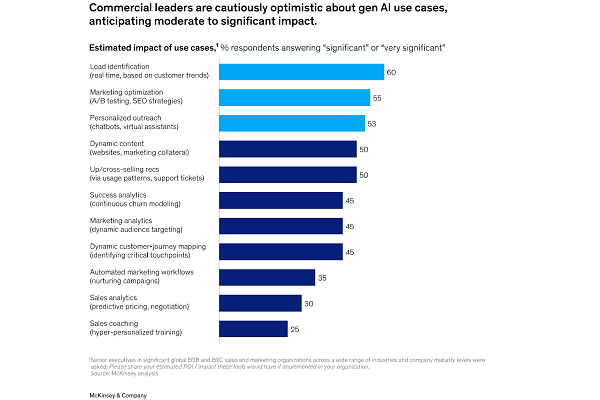Generative AI’s Leadership in Lead Generation [Charts]
 Business leaders imagine a place for generative AI in every facet of sales and marketing, according to a McKinsey survey. Commercial executives surveyed are particularly excited to incorporate tools built on generative AI into lead generation, marketing optimization, and personalized outreach, but no aspect of customer experience is excluded from potential changes.
Business leaders imagine a place for generative AI in every facet of sales and marketing, according to a McKinsey survey. Commercial executives surveyed are particularly excited to incorporate tools built on generative AI into lead generation, marketing optimization, and personalized outreach, but no aspect of customer experience is excluded from potential changes.
Leading AI
Finding leads and improving marketing and outreach are all centered on identifying and engaging prospective customers when they first interact with a brand. This reflects the vast troves of data available to analyze interested leads and the historical challenge of tailoring large-scale initial marketing. According to the findings, generative AI surpasses traditional AI lead targeting by enabling more advanced and nuanced audience segmentation. This allows for highly tailored lead campaigns compared to broader web scraping and basic prioritization approaches.
The technology can also optimize marketing assets like webpages, advertisements, and search engine optimization through predictive analytics. By A/B testing elements and generating data-driven recommendations, generative AI maximizes return on investment. Later in the sales process, personalized content and contextual chatbot interactions powered by generative AI lead to higher customer engagement and conversion rates. The study highlights follow-up emails, chatbot support, and virtual sales assistants as key use cases.
“Gen AI’s advanced algorithms can leverage patterns in customer and market data to segment and target relevant audiences,” the study states. “With these capabilities, businesses can efficiently analyze and identify high-quality leads.”
Generative AI can also provide negotiators with real-time guidance by analyzing past deal data and competitive dynamics during active sales discussions. This empowers sales teams to secure optimal pricing and terms. Post-sale applications include AI-generated customer onboarding materials and predictive churn analytics to improve retention. Personalized training content and chatbots create positive early experiences, while continuous monitoring of usage patterns identifies at-risk accounts. While optimistic about the potential, executives expressed measured expectations for generative AI’s impact. But the study concluded that “cautious optimism” exists across proposed use cases.
Follow @voicebotai Follow @erichschwartz








